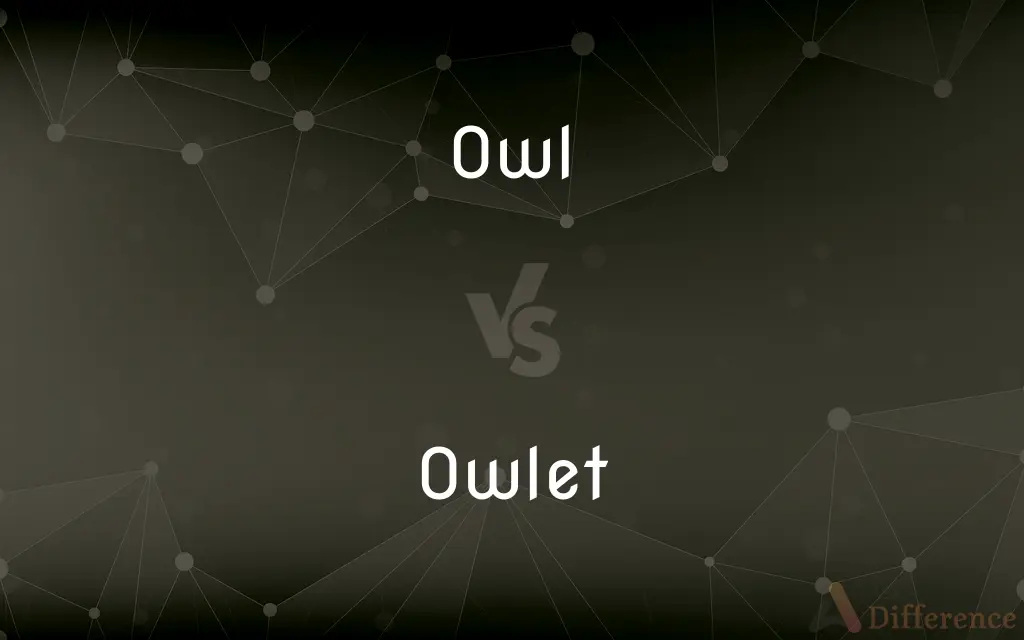Owl vs. Owlet — What's the Difference?
By Fiza Rafique & Maham Liaqat — Updated on April 29, 2024
Owls are adult birds known for their silent flight and nocturnal habits, while owlets refer specifically to their young, showcasing developmental differences in size and maturity.

Difference Between Owl and Owlet
Table of Contents
ADVERTISEMENT
Key Differences
Owls are mature birds of prey with fully developed hunting skills and the ability to fly silently, which aids in catching prey during the night. On the other hand, owlets are juvenile owls, not yet proficient in these skills and often dependent on their parents for food and protection.
The physical size and plumage of an owl are fully formed, providing camouflage and facilitating silent flight, whereas owlets are smaller, with downy feathers that gradually mature into adult plumage.
Owls participate actively in breeding, including nest building and territory defense. In contrast, owlets are the beneficiaries of these efforts, remaining in the nest and learning survival skills from their parents.
In terms of vocalization, owls have a range of calls used for communication, including mating and territorial signals. Owlets, however, typically produce softer, less varied calls that serve primarily to signal hunger or distress.
The diet of an owl consists of a variety of prey, which they hunt using their advanced senses and flying skills. Owlets, on the other hand, start with regurgitated food provided by their parents, gradually learning to hunt as they grow.
ADVERTISEMENT
Comparison Chart
Age
Adult
Juvenile
Skills
Advanced hunting, flying
Developing hunting, learning to fly
Dependency
Independent
Dependent on parents
Vocalization
Varied calls (mating, territorial)
Primarily hunger or distress calls
Role in Life Cycle
Breeder, protector
Being raised, learning
Compare with Definitions
Owl
Owls are often seen as symbols of wisdom in various cultures.
An owl figurine perched on the bookshelf as a symbol of knowledge.
Owlet
Owlets are often found in the nest, being fed by parents until they can fly.
The mother owl returned to the nest with food for her owlets.
Owl
Known for their rotational necks, owls can turn their heads up to 270 degrees.
The owl turned its head sharply to spot the rustling in the bushes.
Owlet
A young owl, especially one that has not yet developed the full characteristics of adults.
The owlet chirped softly, waiting for its parents.
Owl
Owls have exceptional hearing, with ears located at different heights on their heads.
The owl’s acute hearing detected the movements of a mouse under the snow.
Owlet
Vulnerable and dependent, owlets rely on camouflage and parental protection.
The owlet blended into the tree’s bark, hidden from predators.
Owl
Predominantly solitary creatures, owls typically hunt alone.
The solitary owl perched silently, waiting for the dusk to fall.
Owlet
During growth, owlets practice flying under the watchful eyes of their parents.
The owlets flapped their wings clumsily, attempting to lift off.
Owl
A bird of prey known for its distinctive face, nocturnal habits, and silent flight.
The owl swooped down silently to capture its prey.
Owlet
Owlets gradually learn vocalizations and hunting skills from observing their parents.
The owlet watched intently as its parent demonstrated hunting techniques.
Owl
Owls are birds from the order Strigiformes , which includes over 200 species of mostly solitary and nocturnal birds of prey typified by an upright stance, a large, broad head, binocular vision, binaural hearing, sharp talons, and feathers adapted for silent flight. Exceptions include the diurnal northern hawk-owl and the gregarious burrowing owl.
Owlet
A small or young owl.
Owl
Any of various often nocturnal birds of prey of the order Strigiformes, having hooked and feathered talons, a large head with a short hooked beak, large eyes set forward, and fluffy plumage that allows for almost noiseless flight.
Owlet
Diminutive of owl
Owl
Any of several breeds of domestic pigeons having a very short beak somewhat like that of an owl and often a frill of feathers on the chest.
Owlet
A young owl; owling.
Owl
Any of various birds of prey of the order Strigiformes that are primarily nocturnal and have forward-looking, binocular vision, limited eye movement, and good hearing.
Owlet
One of a species of small owls, such as Athene noctua.
Owl
(by extension) A person seen as having owl-like characteristics, especially appearing wise or serious, or being nocturnally active.
Owlet
An owlet moth.
Owl
An owl pigeon.
Owlet
A small owl; especially, the European species (Athene noctua), and the California flammulated owlet (Megascops flammeolus).
Owl
A politician with moderate views that are neither hawkish nor dovish.
Owlet
Young owl
Owl
Any of various nymphalid butterflies, especially in the genus Caligo, having large eyespots on the wings.
Owl
To smuggle contraband goods.
Owl
Any species of raptorial birds of the family Strigidæ. They have large eyes and ears, and a conspicuous circle of feathers around each eye. They are mostly nocturnal in their habits.
Owl
A variety of the domestic pigeon.
Owl
To pry about; to prowl.
Owl
To carry wool or sheep out of England.
Owl
Hence, to carry on any contraband trade.
Owl
Nocturnal bird of prey with hawk-like beak and claws and large head with front-facing eyes
Common Curiosities
Can owlets fly when they are born?
No, owlets cannot fly at birth; they develop this ability as they grow and mature.
What do owlets eat?
Owlets eat food regurgitated by their parents, typically consisting of pre-digested prey.
What is an owlet?
An owlet is a juvenile owl, not yet fully mature and still dependent on parental care.
What are the survival challenges for owlets?
Survival challenges for owlets include predation, learning to hunt, and mastering flight.
What is an owl?
An owl is a nocturnal bird of prey with distinctive facial features and silent flight capabilities.
How do owls communicate?
Owls communicate through a variety of calls, which can include territorial, mating, and alert calls.
How do owls and owlets differ in their hunting abilities?
Owls are skilled hunters with precise flying and hunting techniques, whereas owlets are still in the learning phase.
How long do owlets stay with their parents?
Owlets stay with their parents until they are capable of hunting and surviving independently, which can vary by species.
What adaptations help owls hunt at night?
Owls have adaptations like excellent night vision and asymmetrically placed ears for superior hearing.
Do owls have predators?
Yes, owls can be preyed upon by larger birds of prey and some mammals, depending on their size and habitat.
What is the lifespan of an owl in the wild?
The lifespan of an owl in the wild varies, but some can live up to 20 years or more.
Are all owls nocturnal?
Most owls are nocturnal, but some species are active during the day or at dusk.
How do owls contribute to the ecosystem?
Owls help control rodent populations, thus contributing to the balance of ecosystems.
What kind of habitats do owls prefer?
Owls inhabit a variety of habitats, from dense forests to open prairies, depending on the species.
Can owlets be seen during the day?
Yes, owlets can sometimes be seen during the day, especially if their nest is disturbed.
Share Your Discovery

Previous Comparison
Local vs. Region
Next Comparison
Bronze vs. BrownAuthor Spotlight
Written by
Fiza RafiqueFiza Rafique is a skilled content writer at AskDifference.com, where she meticulously refines and enhances written pieces. Drawing from her vast editorial expertise, Fiza ensures clarity, accuracy, and precision in every article. Passionate about language, she continually seeks to elevate the quality of content for readers worldwide.
Co-written by
Maham Liaqat












































